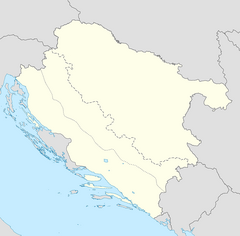| Jadovno | |
|---|---|
| Concentration and extermination camp | |
 The Šaran pit, located one kilometer from the camp. | |
| Coordinates | 44°32′18″N 15°14′20″E / 44.5382°N 15.2388°E |
| Location | Near Gospić, Independent State of Croatia |
| Operated by | Ustaše |
| Operational | April 1941 – August 1941 |
| Inmates | Primarily Serbs and Jews |
| Killed | Estimates generally range from 10,000–68,000 |
| Notable inmates | |
The Jadovno concentration camp was a concentration and extermination camp in the Independent State of Croatia (NDH) during World War II. Commanded by a member of the Ustaše Militia Juraj Rukavina, it was the first of twenty-six concentration camps in the NDH during the war. Established in a secluded area about 20 kilometres (12 mi) from the town of Gospić, it held thousands of Serbs and Jews over a period of 122 days from May to August 1941. Inmates were usually killed by being pushed into deep ravines located near the camp. Estimates of the number of deaths at Jadovno range from 10,000 to 68,000, mostly Serbs. The camp was closed on 21 August 1941, and the area where it was located was later handed over to the Kingdom of Italy and became part of Italian Zones II and III. Jadovno was replaced by the larger Jasenovac concentration camp and its extermination facilities.
The camp site remained unexplored after the war due to the depth of the gorges where bodies were disposed and the fact that some of them had been filled with concrete by Yugoslavia's Communist authorities. Additional sites containing the skeletal remains of camp victims were uncovered in the 1980s. Commemoration ceremonies honouring the victims of the camp have been organized by the Serb National Council (SNV), the Jewish community in Croatia, and local anti-fascists since 2009, and 24 June has since been designated as a "Day of Remembrance of the Jadovno Camp" in Croatia. A monument commemorating those killed in the camp was constructed in 1975 and stood for fifteen years before being removed in 1990. A replica of the original monument was constructed and dedicated in 2010, but disappeared within twenty-four hours of its inauguration.
